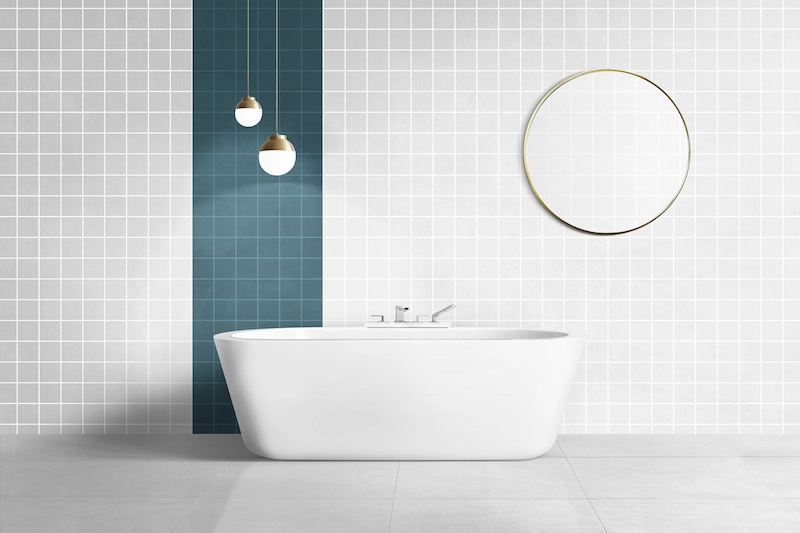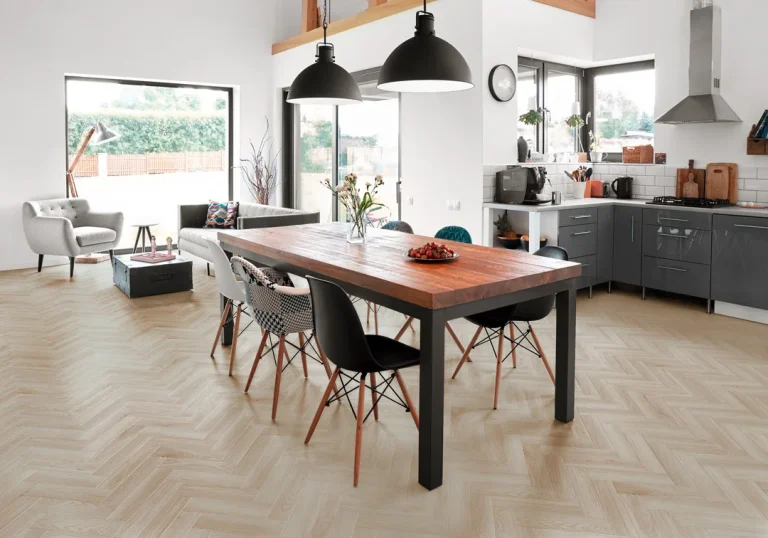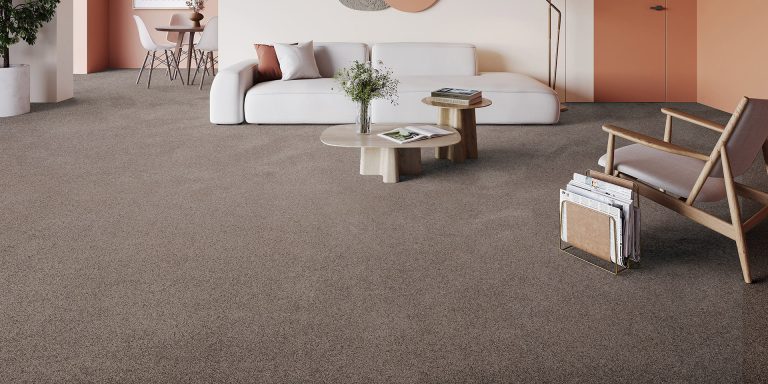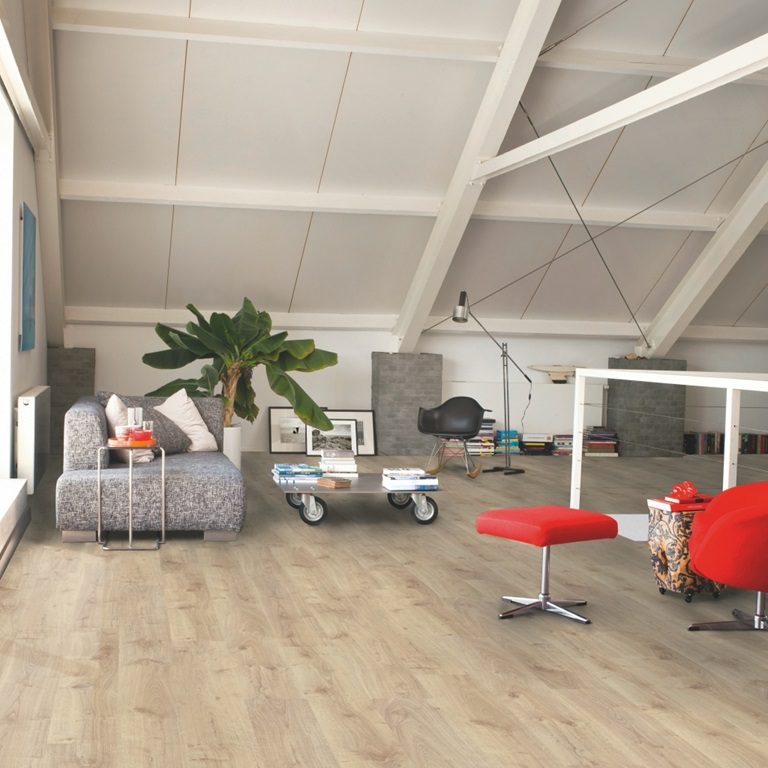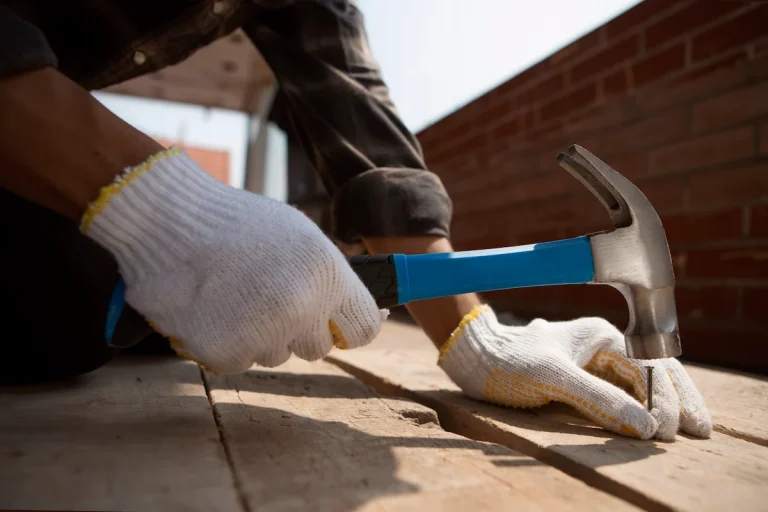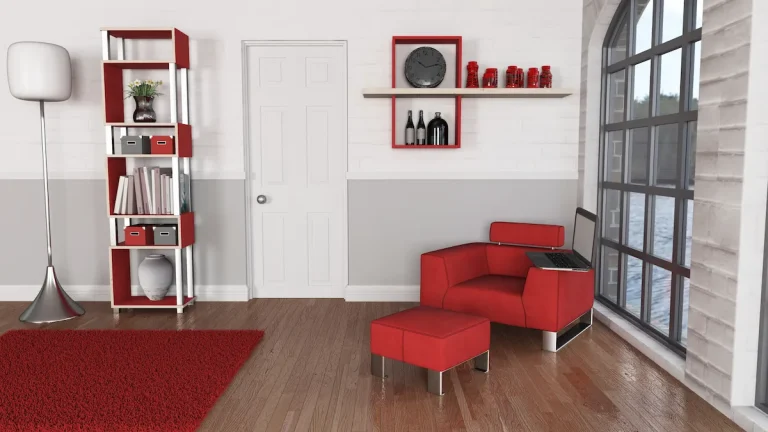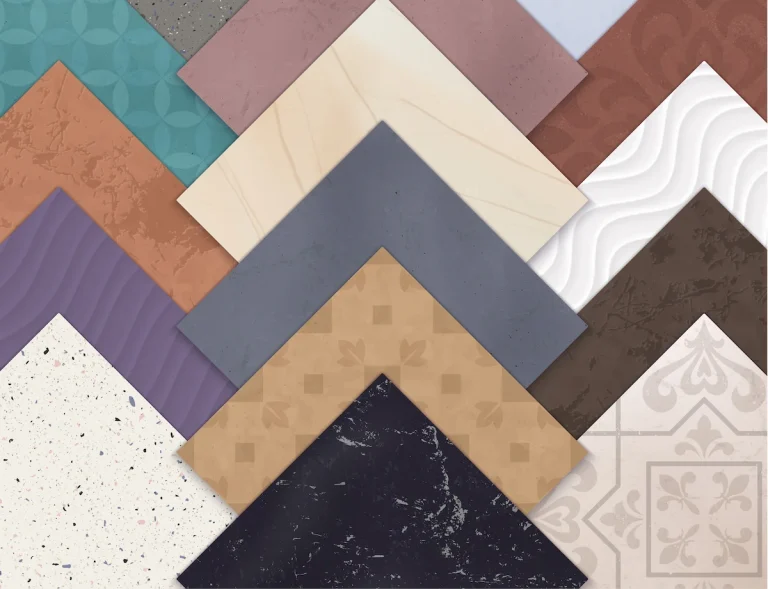Selecting the appropriate flooring for a bathroom is crucial for both functionality and aesthetic appeal. A range of materials is available, including ceramic tile, vinyl, and natural stone, with each option presenting its own distinct advantages and disadvantages.
This guide examines the most prevalent bathroom flooring materials, highlights key factors to consider during the selection process, and outlines the pros and cons associated with each material. Furthermore, it provides a step-by-step installation guide for the chosen flooring, ensuring that the bathroom not only achieves an attractive appearance but also functions effectively.
The Most Common Bathroom Flooring Materials
When selecting flooring for a bathroom, several materials are distinguished by their unique characteristics and suitability for a moisture-rich environment. Commonly used bathroom flooring materials include:
- Ceramic tiles
- Vinyl flooring
- Laminate
- Natural stone
- Cork
- Linoleum
Each of these options offers distinct advantages, such as water resistance, durability, and aesthetic appeal. The selection of the appropriate flooring material is essential for a successful home renovation project, as it significantly influences both the functionality and the visual aspects of the space.
a. Ceramic Tile
Ceramic tile is a widely recognised option for bathroom flooring, owing to its excellent water-resistant properties and the extensive range of stylish designs that can complement any interior design theme.
Plus its aesthetic appeal, this flooring option offers numerous benefits that make it a prudent investment for many homeowners. Its high durability allows it to endure significant foot traffic, rendering it particularly suitable for busy households. The low maintenance requirements facilitate easy cleaning; typically, a simple sweeping and occasional mopping suffice to maintain its appearance. Furthermore, it is compatible with underfloor heating systems, creating a warm and inviting environment during colder months, which can enhance overall comfort.
Benefits:
- Exceptional durability
- Easy to clean
- Compatible with heating solutions
Potential drawbacks include a cold feel underfoot unless appropriately heated, as well as the risk of cracking if heavy objects are dropped. When evaluating options for bathroom flooring, it is essential to carefully consider these factors.
b. Vinyl
Vinyl flooring, particularly luxury vinyl tiles, is increasingly preferred for bathroom environments due to its cost-effectiveness, moisture-resistant properties, and straightforward installation process.
This adaptable flooring option is available in a wide array of styles and designs, making it an excellent choice for homeowners seeking to enhance the aesthetics of their bathrooms. From lifelike imitations of wood and stone to vibrant colours and patterns, vinyl flooring is capable of accommodating diverse tastes and preferences.
Notable benefits of vinyl flooring include:
- Slip-resistant options that promote safety even in wet conditions,
- An extensive range of textures that impart a luxurious feel,
- Low-maintenance surfaces that require only occasional cleaning to maintain their appearance.
Whether the objective is to establish a contemporary bathroom ambience or a classic spa-like retreat, vinyl flooring can seamlessly work together with various design themes.
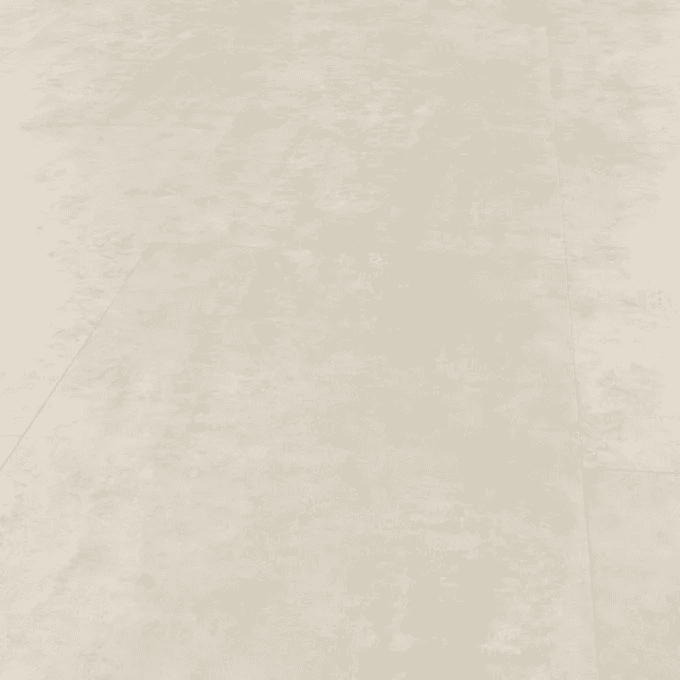

See product: Camaro Tile White Metalstone
c. Laminate
Laminate flooring has emerged as a cost-effective solution for bathroom renovations, providing the aesthetic appeal of wood flooring while also offering high durability and resistance to moisture. Its layered construction typically comprises a core made from high-density fibreboard, which provides stability and strength, a photographic layer that replicates the appearance of natural wood or tile, and a wear layer that protects against scratches and stains.
This innovative flooring solution not only enhances the visual appeal of a space but is also relatively easy to maintain, making it a preferred option among homeowners seeking to upgrade their interiors. Additionally, many manufacturers are now producing laminate flooring that incorporates eco-friendly materials and low-VOC adhesives, contributing to a healthier environment for both the residence and its occupants.
While laminate flooring presents several advantages, it is important to consider certain drawbacks:
- It is susceptible to water damage if not adequately sealed or installed.
- It offers a less authentic feel compared to real hardwood.
When used in bathrooms, it is crucial to ensure proper installation and select products specifically designed for high-moisture areas, thereby achieving an effective combination of style and functionality.
See product: Quick-Step Classic Misty Grey Oak
d. Natural Stone
Natural stone flooring, such as marble or granite, offers a distinctive aesthetic appeal to bathrooms, characterised by stylish designs and high durability; however, it necessitates meticulous maintenance.
When considering the incorporation of stone into their bathrooms, homeowners often value its natural elegance and the manner in which it enhances the overall ambience of the space. Utilising natural stone presents both advantages and challenges.
- Water Resistance: Natural stone demonstrates considerable resistance to water, particularly when adequately sealed. This property renders it suitable for areas subjected to frequent moisture exposure.
- Maintenance Needs: Conversely, it requires regular sealing and the use of specific cleaning products to prevent etching or discolouration, which can present greater maintenance challenges compared to other materials.
- Underfloor Heating: Homeowners may also integrate underfloor heating with stone flooring, providing a comfortable and warm surface, especially in colder climates.
In conclusion, while the initial installation and ongoing maintenance may require considerable effort, the enduring beauty and resilience of natural stone render it a compelling choice for discerning homeowners.
e. Cork
Cork flooring is an environmentally friendly option that is increasingly favored for bathroom applications due to its moisture-resistant properties and comfortable underfoot experience.
Plus its appealing tactile qualities, this sustainable material provides numerous benefits that contribute to a healthier living environment. The natural insulation characteristics of cork not only help maintain warmer temperatures during the winter months but also enhance energy efficiency throughout the year. Furthermore, the sound-absorbing properties of cork create a tranquil atmosphere, making it an ideal choice for any household.
However, users should be aware of certain potential challenges:
- While durable, cork flooring may be susceptible to scratches and dents, particularly in high-traffic areas.
- Regular maintenance, including sealing and cleaning, is necessary to preserve its aesthetic and functional qualities.
In summary, cork flooring presents a compelling option for individuals seeking both comfort and sustainable design in their bathroom renovation projects.
f. Linoleum
Linoleum is an environmentally sustainable and cost-effective flooring solution for bathrooms, recognised for its ease of installation and extensive range of colours and patterns.
This flooring material not only enhances the visual appeal of a bathroom but also emphasises sustainability, making it a responsible choice for environmentally conscious homeowners. Linoleum is composed of natural materials such as linseed oil, cork dust, and wood flour, which decompose without causing harm to the environment.
Maintaining linoleum is uncomplicated; regular sweeping and occasional damp mopping are typically sufficient to preserve its appearance. Its durable surface is resistant to wear and tear, ensuring a long service life.
Modern linoleum options feature slip-resistant textures, enhancing safety in wet bathroom environments. These advancements facilitate the creation of a stylish yet functional space, offering both comfort and security.
Incorporating linoleum into bathroom designs can yield an elegant atmosphere, customised to the homeowner’s preferences while upholding a commitment to eco-friendliness.
Factors Should Be Considered When Choosing Bathroom Flooring Materials
When selecting bathroom flooring materials, it is essential to consider several critical factors to ensure that the chosen material meets the specific requirements of the space. These factors include:
1. Water Resistance
Water resistance is a critical factor to consider when selecting flooring for bathrooms, as constant exposure to moisture can result in damage, mould, and mildew if the material is not adequately equipped to withstand such conditions.
It is important to recognise that various flooring materials offer differing levels of water resistance, which significantly influences their durability and safety in a humid environment. For instance, materials such as porcelain tiles and luxury vinyl planks are specifically designed to resist water effectively, making them ideal choices for bathrooms. Conversely, materials like hardwood and carpet are considerably less suitable, as they can absorb moisture and promote mould growth, thereby posing potential health risks.
- Porcelain Tiles: Renowned for their durability and waterproof characteristics, porcelain tiles are a preferred option for wet areas.
- Luxury Vinyl: This material combines aesthetic appeal with functionality; it is water-resistant and often replicates the appearance of natural wood or stone.
- Natural Stone: While aesthetically pleasing, stones such as marble may require sealing to enhance their water resistance, making them less suitable for some budget-friendly home improvement projects.
- Hardwood: Generally, hardwood is not recommended for bathroom applications due to moisture-related concerns.
Consequently, selecting the appropriate flooring type not only influences the immediate visual appeal of the bathroom but also plays a significant role in minimising maintenance challenges over time.
2. Durability
Durability is a critical factor to consider when selecting flooring materials for bathrooms, as these materials must endure the wear and tear associated with high foot traffic and exposure to moisture.
When evaluating options, it is important to recognise that various materials exhibit differing levels of durability, which directly influences their long-term effectiveness.
- Tile is a widely favoured choice due to its excellent resistance to impacts and moisture, making it particularly suitable for wet environments.
- Vinyl, while generally more cost-effective and one of the affordable options, can also perform adequately; however, it may necessitate more frequent replacements due to wear and tear.
- Natural stone, including granite and marble, offers a timeless aesthetic and high durability; yet, it is important to note that these materials can be porous, requiring regular sealing to maintain their integrity.
Ultimately, selecting a material that balances high durability with manageable maintenance will ensure that the bathroom floor remains visually appealing while effectively serving its purpose for many years.
3. Slip Resistance
Slip resistance is an essential safety feature to consider when selecting flooring for bathrooms, as wet surfaces can significantly increase the risk of accidents and injuries. Prioritising slip resistant and non-slip flooring options is crucial for minimising such risks.
The importance of non-slip flooring cannot be overstated, especially in both residential and commercial environments where moisture is commonly present. Ensuring that the chosen flooring material offers adequate grip can markedly decrease the likelihood of slips and falls, which are prevalent hazards in bathrooms.
When selecting an appropriate flooring option, it is imperative to evaluate various materials, including vinyl, tiles, and specialised coatings, as each provides different levels of traction.
- Vinyl flooring frequently features textured surfaces that enhance grip.
- Porcelain tiles can also be treated with anti-slip finishes.
- Rubber flooring offers durable slip resistance that is suitable for both residential and commercial applications, providing peace of mind and effective moisture resistance.
In conclusion, investing in slip-resistant flooring not only enhances safety but also fosters peace of mind during everyday use.
4. Maintenance and Cleaning
The maintenance and cleaning requirements of bathroom flooring can significantly influence the selection of materials, as certain options necessitate more effort than others to maintain in optimal condition.
The choice of flooring extends beyond mere aesthetics; it directly affects daily routines and overall satisfaction. For example, while ceramic tiles are known for their durability and water resistance, they can be cold underfoot and require regular scrubbing to preserve their lustre. Conversely, vinyl flooring provides a softer and warmer feel, typically requiring only a simple sweeping and mopping routine, which makes it an appealing choice for families or individuals with busy lifestyles. Additionally, engineered wood and bamboo present stylish and eco-friendly options that require specific cleaning maintenance methods.
The following are common flooring types along with their respective cleaning requirements:
- Porcelain Tiles: Resistant to stains and easy to disinfect; however, the grouting may require periodic maintenance.
- Natural Stone: Offers a stunning and unique appearance, yet it often necessitates sealing and the use of specialised cleaners to prevent damage.
- Laminates: Moisture-resistant, but they can accumulate dirt; thus, regular sweeping and occasional damp mopping are sufficient.
Understanding these variations is essential for making an informed decision, ensuring that the chosen flooring aligns with lifestyle preferences while fulfilling maintenance expectations.
5. Style and Aesthetics
Style and aesthetics are critical factors in the selection of bathroom flooring, as the chosen material must harmonise with the overall interior design theme of the space. Selecting the appropriate flooring can transform a conventional area into an inviting sanctuary, reflecting individual taste while simultaneously enhancing functionality. Design choices such as tarkett and solid wood can offer unique textures and a luxurious feel.
When evaluating various flooring materials, options such as porcelain tiles, natural stone, and sustainable bamboo significantly enhance the bathroom’s overall appearance.
- Porcelain tiles provide versatility in colour and design, allowing for intricate patterns or a clean, modern finish.
- Natural stone offers a luxurious ambience with its unique textures and hues, imparting a distinctive character to each bathroom.
- Eco-friendly options, such as bamboo or cork, present sustainable alternatives that are both stylish and functional, thereby contributing to a healthier environment.
Ultimately, whether one chooses sleek tiles or warm, organic materials, the right flooring can establish a cohesive and aesthetically pleasing atmosphere in any bathroom.
The Pros and Cons of Each Bathroom Flooring Material
It is essential to understand the advantages and disadvantages of each common bathroom flooring material in order to make an informed decision. Each option—whether ceramic tiles, vinyl, laminate, natural stone, cork, or lino—presents distinct benefits and challenges that can significantly influence overall satisfaction and the final choice. Waterproof flooring options are often preferred for their easy installation and minimal maintenance requirements.
1. Ceramic Tile
Ceramic tile is recognised for its impressive water resistance and aesthetically pleasing designs; however, it may present challenges such as coldness underfoot and the need for grout maintenance over time.
When evaluating options for home flooring, one must acknowledge the remarkable versatility that ceramic tile provides. It is available in an extensive array of colours, patterns, and sizes, allowing for customisation to align with various aesthetic preferences and design visions. Its durability ensures it can withstand heavy foot traffic and resist scratches and stains, rendering it a prudent investment for both residential and commercial settings.
While the resilience of ceramic tile is a significant advantage, it is important to note that users may find the tile’s hardness and cool surface less comfortable for prolonged periods of standing. Additionally, essential maintenance practices, such as regular cleaning and timely grout sealing, are necessary to maintain its visual appeal and performance.
In conclusion, understanding both the benefits and maintenance requirements associated with ceramic tile enables homeowners to make informed decisions that effectively balance style and functionality.
2. Vinyl
Vinyl flooring is recognised for its cost-effectiveness, affordable options, and ease of installation; however, it may not provide the same durability as some other materials, particularly under conditions of heavy foot traffic or exposure to sharp objects.
Despite these considerations, vinyl flooring remains a favoured option among homeowners due to its numerous advantages. The comfort it offers underfoot is significant, making it an ideal choice for individuals who spend extended periods standing or walking. Additionally, the wide variety of styles and design choices available allow for creative flexibility, enabling homeowners to achieve their desired aesthetic without compromising functionality.
While the potential for scratches is a valid concern, advancements in vinyl manufacturing have resulted in more resilient options that effectively resist wear and tear. Maintaining the flooring’s appearance typically involves straightforward tasks, such as regular cleaning and occasional polishing, which can significantly extend its lifespan.
- Variety of designs to complement any décor
- Comfortable surface suitable for prolonged use
- Easy maintenance and repair options
3. Laminate
Laminate flooring offers the aesthetic appeal of wood flooring combined with high durability; however, it can be susceptible to moisture damage if not adequately sealed. Its surface can be made water resistant with proper sealing techniques.
This flooring option addresses the aesthetic preferences of homeowners, but its performance in high-humidity areas, such as kitchens and bathrooms, may present concerns. Its moisture resistant features can be enhanced with additional treatments. Users frequently appreciate the ease of installation and the variety of designs available, contributing to its popularity in interior spaces.
It is essential to exercise caution regarding moisture exposure, as laminate flooring does not withstand spills and moisture effectively without proper sealing. Regular maintenance involves straightforward cleaning routines that can enhance the longevity of the surface.
Key advantages include:
- The undeniable visual appeal, closely resembling genuine hardwood.
- Installation that can be performed with relative ease, often without the need for professional assistance.
- Simple clean-up procedures; however, excessive moisture can result in warping.
Ultimately, homeowners should thoughtfully evaluate their specific environment and usage to determine whether laminate flooring represents the most practical choice for their needs.
4. Natural Stone
Natural stone flooring is valued for its aesthetic appeal and exceptional durability; however, it requires considerable maintenance and can involve substantial installation costs.
The radiant hues and unique textures of natural stone have the potential to transform any living space into a luxurious environment. Nonetheless, it is imperative to balance these aesthetic benefits with the practical considerations of installation and routine maintenance. Many homeowners are captivated by the prospect of incorporating natural stone; however, they must take into account several factors, including:
- Installation Costs: The initial investment can be significant, influenced by the type of stone selected and the complexity of the installation process.
- Maintenance: Regular sealing and meticulous cleaning are essential to maintain its lustre and prevent deterioration.
- Long-Term Value: Despite the initial high costs, the inherent durability can result in lower replacement frequencies over time.
Natural stone presents a compelling combination of aesthetic allure and longevity; however, prospective buyers should ensure they are adequately prepared for the ongoing responsibilities associated with its upkeep.
5. Cork
Cork flooring is an environmentally friendly option that provides a comfortable surface; however, it may be less durable and more susceptible to water damage than other flooring materials.
This sustainable flooring solution contributes to a healthy environment due to its renewable nature, making it essential to weigh its advantages and disadvantages before making an investment. Cork flooring is derived from the bark of cork oak trees, ensuring that the trees themselves remain unharmed during the harvesting process. Its natural insulation properties enhance thermal comfort and sound absorption, fostering a tranquil atmosphere in any residence.
Despite these benefits, homeowners may need to exercise additional precautions, as cork is porous and can be vulnerable to scratches and spills. Maintaining its aesthetic appeal and functionality necessitates proper care, which includes regular sealing and avoiding the presence of standing water.
While cork flooring offers considerable sustainability benefits and comfort, understanding its limitations is critical for ensuring long-term satisfaction.
6. Linoleum
Linoleum flooring represents an environmentally friendly option that is easy to maintain; however, it may not possess the durability necessary for high-traffic bathroom areas.
This organic flooring choice not only enhances aesthetic appeal but also incorporates renewable materials that contribute to a sustainable environment. In terms of maintenance, linoleum is relatively uncomplicated; regular sweeping and occasional mopping can preserve its vibrant appearance. It exhibits resistance to stains and can be easily repaired if damaged, making it a favourable option for many households.
It is essential to consider these advantages alongside potential durability concerns, particularly in areas that experience significant foot traffic or moisture. While linoleum can endure light usage, it may require more frequent replacement compared to other sturdier flooring alternatives.
Advantages of Linoleum:
- Eco-friendly composition
- Low maintenance requirements
- Stain resistance
Ultimately, the decision should be based on individual lifestyle needs and the specific requirements of the space being renovated or constructed.
How to Install Bathroom Flooring Properly
Proper installation of bathroom flooring necessitates meticulous planning and execution to ensure that the selected material functions optimally in a moisture-rich environment.
This process encompasses various stages, including the preparation of the subfloor, the application of adhesive or grout, and the final finishing touches.
1. Preparing the Subfloor
Preparing the subfloor is an essential initial step in the installation of bathroom flooring, ensuring a level surface that can effectively manage moisture and prevent future complications.
A properly prepared subfloor serves not only as a solid foundation but also plays a critical role in maintaining the integrity of the entire flooring system. Proper levelling is vital, as even the slightest imperfections can result in uneven wear and potential damage over time. To achieve an optimal subfloor, various methods may be utilised, including:
- Employing self-levelling compound to address significant dips and humps
- Utilising a floor patching compound for minor imperfections
- Installing backer board to enhance moisture resistance
Moisture control is of utmost importance in areas susceptible to humidity. This may involve the installation of a vapour barrier or ensuring sufficient ventilation. Additionally, addressing any necessary repairs, such as fixing squeaky boards or replacing damaged sections, will significantly contribute to the overall success of the flooring installation.
2. Measuring and Cutting the Flooring Material
Accurate measurement and cutting of flooring materials are essential for a seamless installation in bathroom flooring, necessitating the use of appropriate tools and techniques to ensure precise fits.
Proper planning serves as the foundation of a successful flooring project, as it aids in the prevention of costly errors and minimises material waste. Before commencing the project, it is advisable to gather the necessary tools, which include:
- Measuring tape
- Square for ensuring straight cuts
- Utility knife for vinyl or laminate flooring
- Circular saw for hardwood or tiles
- Safety gear, such as goggles and gloves
Once these tools have been assembled, the process should begin with precise measurements of the area to be covered. This step includes accounting for any irregularities in the floor space that may impact the layout and cutting.
After determining the required dimensions, it is imperative to carefully cut the flooring materials according to these measurements, ensuring to allow for expansion gaps where necessary. The success of the installation relies heavily on both the planning and execution phases, underscoring the importance of diligence and accuracy throughout the entire process.
3. Applying Adhesive or Grout
The proper application of adhesive or grout is essential for ensuring that bathroom flooring is securely installed, providing a stable and moisture-resistant finish. For optimal results in a bathroom, selecting the right materials to achieve a water resistant surface is crucial.
To achieve optimal results, it is crucial to select the appropriate adhesive or grout based on the type of flooring being installed. For example, ceramic tiles typically require thin-set mortar, while vinyl flooring may benefit from an acrylic adhesive. Adequate surface preparation is critical; the surface must be clean, dry, and free from any old adhesive residues that could compromise the integrity of the bond.
- Measure accurately: Ahead of application, it is imperative to accurately measure materials to prevent mismatches.
- Use the right tools: Utilise a notched trowel for adhesive application to ensure an even layer, and a grout float to distribute the grout smoothly.
- Avoid overgrouting: Excessive grout can result in unsightly hazing on tile surfaces; thus, consistency in application is essential.
It is advisable to work in small sections and to clean any excess material promptly to maintain a neat finish. By adhering to these techniques, one can ensure a durable and aesthetically pleasing floor that withstands moisture, while minimising common pitfalls that could jeopardise its longevity.
4. Sealing the Edges and Joints in the Bathroom
Sealing the edges and joints of bathroom flooring is essential for preventing moisture infiltration, which can result in damage and mould growth. Ensuring proper sealing is crucial for maintaining the integrity and appearance of your bathroom.
To ensure effective moisture protection, selecting the appropriate sealing materials is critical. High-quality silicone sealant specifically designed for bathroom applications is highly recommended, as these products resist mould and mildew while adhering effectively to various surfaces. Ahead of the application of any sealant, it is imperative to prepare the surface properly. This preparation entails thoroughly cleaning the area and allowing it to dry completely.
Regular maintenance is significant for ensuring the longevity of the sealing. Periodically monitoring the condition of the sealant and addressing any cracks or signs of wear promptly can avert more extensive issues in the future. The following best practices should be considered:
- Apply sealant in a continuous bead to ensure complete coverage.
- Avoid overapplication, as this may result in unsightly messes.
- Ensure adequate ventilation to facilitate curing and achieve optimal results.
By adhering to these guidelines, the sealing process will not only protect the bathroom floor from moisture but also contribute to a healthier living environment.
5. Finishing Touches and Clean Up
The final stages of bathroom flooring installation entail the addition of finishing touches and the meticulous cleaning of the work area to present a polished and ready-to-use space.
During this critical phase of bathroom installation, it is imperative to ensure that all materials have been properly positioned and that no remnants of the installation process remain. A thorough cleaning is essential to achieving a flawless finish. Begin by removing any dust or debris that may have been left behind, using a gentle vacuum or broom.
- Inspect the flooring for any gaps or imperfections, ensuring that these are filled as necessary.
- Wipe down all surfaces with an appropriate cleaner to enhance their appearance.
Before making the bathroom available for use, confirm that all fixtures have been properly installed and run water to check for any leaks. Adhering to these precautions not only fosters a safe environment but also guarantees that the space is both inviting and functional.
Ready to transform your bathroom with the perfect flooring? At TEKA Flooring, we offer a wide selection of high-quality bathroom flooring materials to suit every style and need. Our expert team is here to help you choose the best option and ensure flawless installation for a stunning finish.
Contact TEKA Flooring today to start your bathroom flooring project and elevate your space with confidence!
Read also:


























